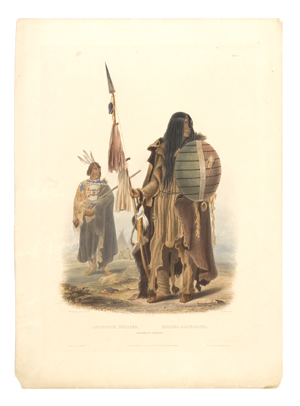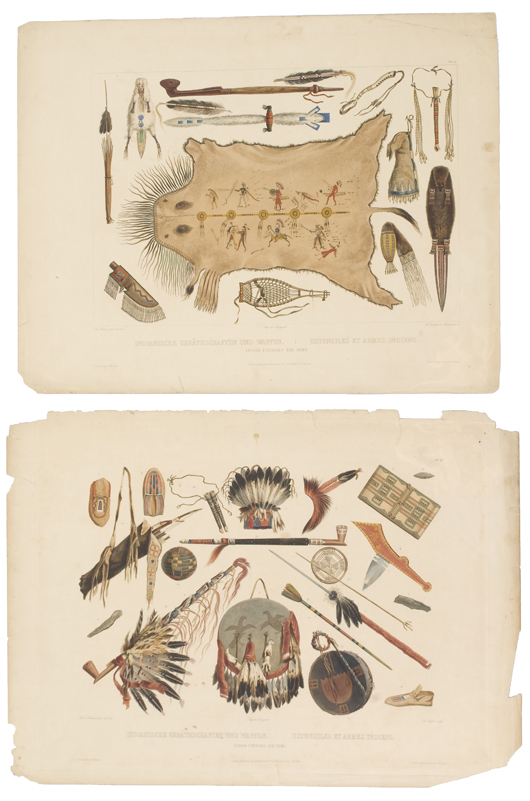
At this time, a surge of visual material related to the American Indian tribes began to surface. This sudden appearance was largely due to the work of two artists working separately, albeit under parallel circumstances. Karl Bodmer (Swiss, 1809-1893), George Catlin (American, 1796-1872).
The monumental (and unlikely) figures of this movement, Karl Bodmer and George Catlin, came from very different circumstances – Catlin the purely American capitalist and relentless self-promoter, Bodmer the reserved, quiet Swiss printmaker and draftsman. Each produced an enormous body of work that survives, amazingly, in original form and in the form published prints.
George Catlin began his artistic career as a miniature portrait painter in Philadelphia, common work for an artist attempting to make a living. Catlin became fascinated with Native Americans after witnessing a delegation of Native Americans in Philadelphia. In 1830, Catlin joined a diplomatic mission up the Mississippi River. From 1830-1836, Catlin took five trips, resulting in an abundance of original portraits, landscapes and cultural studies. St. Louis was his base of operations, and paintings were stored there until Catlin felt he had amassed enough material to market back East.
Catlin was a gifted promoter, and often remarked that the American Indian tribes were rapidly disappearing, highlighting the rarity of his paintings. By 1838, Catlin had fully cataloged his collection and displayed them in his great Indian Gallery in New York. Unable to sell his entire collection to the United States government, Catlin took his gallery on tour through Europe, and eventually sold his collection, to a wealthy Philadelphia collector. Amazingly, the collection of original paintings survives today. If the Smithsonian purchased the works as Catlin had originally intended, the collection would have almost certainly burned in the 1865 fire that consumed the Smithsonian.
Catlin’s North American Indian Portfolio was published in 1844. Each with 25 color plates these volumes were inexpensive and accessible to the common collector. Most of these are broken out, or divided into single plates and framed. They regularly surface on the market and are in demand. Catlin’s originals are primarily at the Smithsonian or in institutional hands.
Karl Bodmer, Swiss born draftsman, was selected to accompany German explorer Prince Maximilian zu Wied on a scientific expedition to North America, specifically to document the native tribes, geography, and various animal and plant species. From 1832-1834, Bodmer’s group traveled along the Missouri River, recording their findings. Bodmer explored the same period as Catlin and produced an enormous body of work, primarily watercolors, focusing on American Indian subjects and their art, utensils and cultural ceremonies, as well as landscapes. Bodmer’s work was incredibly precise, and is viewed by scholars today as being a more accurate representation of the various American Indian tribes.
Upon returning to Germany, Bodmer became engaged in the printing process. Eighty-one illustration plates were designed as hand-colored etchings and aquatints, to be incorporated into Prince Maximilian’s Travels in the Interior of North America, published in London in 1839. Like Catlin, Bodmer’s prints usually surface on the market today as individual plates. His entire collection of original watercolors now resides at the Joslyn Art Museum in Omaha, Neb.
In today’s market, both Bodmer and Catlin works on paper command strong prices at auction. Though numerous plates were produced, they are rare to find them in good condition, and they are some of the first examples of American Indian subjects produced in printed form.
Wes Cowan is founder and owner of Cowan’s Auctions Inc. in Cincinnati. An internationally recognized expert in historic Americana, Wes stars in the PBS television series History Detectives and is a featured appraiser on Antiques Roadshow. He can be reached via email at info@cowans.com. Research by Graydon Sikes.
ADDITIONAL LOTS OF NOTE



